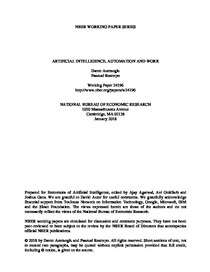Artificial intelligence, automation and work
"We summarize a framework for the study of the implications of automation and AI on the demand for labor, wages, and employment. Our task-based framework emphasizes the displacement effect that automation creates as machines and AI replace labor in tasks that it used to perform. This displaceme...
| Main Authors: | , , |
|---|---|
| Institution: | ETUI-European Trade Union Institute |
| Format: | TEXT |
| Language: | English |
| Published: |
Cambridge, MA
2018
NBER |
| Subjects: | |
| Online Access: | https://www.labourline.org/KENTIKA-19399080124911172629-artificial-intelligence,-autom.htm |
| Summary: | "We summarize a framework for the study of the implications of automation and AI on the demand for labor, wages, and employment. Our task-based framework emphasizes the displacement effect that automation creates as machines and AI replace labor in tasks that it used to perform. This displacement effect tends to reduce the demand for labor and wages. But it is counteracted by a productivity effect, resulting from the cost savings generated by automation, which increase the demand for labor in non-automated tasks. The productivity effect is complemented by additional capital accumulation and the deepening of automation (improvements of existing machinery), both of which further increase the demand for labor. These countervailing effects are incomplete. Even when they are strong, automation in- creases output per worker more than wages and reduce the share of labor in national income. The more powerful countervailing force against automation is the creation of new labor-intensive tasks, which reinstates labor in new activities and tends to increase the labor share to counterbalance the impact of automation. Our framework also highlights the constraints and imperfections that slow down the adjustment of the economy and the labor market to automation and weaken the resulting productivity gains from this transformation: a mismatch between the skill requirements of new technologies, and the possibility that automation is being introduced at an excessive rate, possibly at the expense of other productivity-enhancing technologies." |
|---|---|
| Physical Description: | 43 p. Digital |

